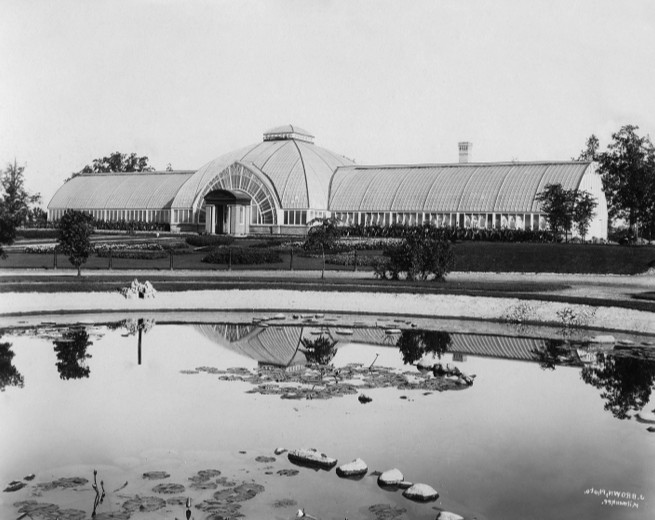Today, the National Trust for Historic Preservation released a new engineering report on the state of the Mitchell Park Horticultural Conservatory – commonly called the Domes – that the trust says "demonstrates a more comprehensive and cost-effective path forward for preserving the Domes."
As importantly, the trust also today declared the Domes to be a National Treasure. Tell us something we don’t know!
The report and the declaration arrived in advance of today’s meeting of the Milwaukee County Task Force on the Domes. That meeting is slated for 5:30 p.m. in the lobby of the Domes, 524 S. Layton Blvd.
You can read a variety of reports and other background data on the Domes and their condition here. Take a behind-the-scenes tour of the Domes here.
"Anyone who has visited the Milwaukee Domes can appreciate what a stunning and absolutely one-of-a-kind place they are," said Stephanie Meeks, president and CEO of the National Trust for Historic Preservation, in a statement. "From our work at other icons of modern architecture, like Houston’s Astrodome or Philip Johnson’s Glass House, we also know that inspiring, innovative architecture often requires equally creative solutions. Rather than risk losing this iconic piece of Milwaukee’s heritage, we need a thoughtful, long-term preservation solution for the challenges facing the Domes."
The Domes have long captured the public’s interest, beginning in 1958 when Milwaukee architect Donald Grieb won a national design competition for a new horticultural conservatory in Mitchell Park.
His design for a trio of the world’s first conoidal (cone-shaped) domes would replace the more traditional iron and glass conservatory that Henry C. Koch designed in homage to London’s storied Crystal Palace.

(PHOTO: Courtesy of Friends of the Domes)
Koch’s greenhouse was built in 1898 and local ironmaster Cyril Colnik designed the green palace’s gates, which can still be seen in the Show Dome. Koch’s conservatory was demolished in 1955.
Construction on the Domes began in 1959 and work was completed eight years later. The Domes were an immediate Milwaukee landmark, popping up on Milwaukee postcards and posters – and in more unexpected places – for years to come.

(PHOTO: Courtesy of Friends of the Domes)
In February 2016, the Domes were closed when construction materials began to fall to the floor. They began to reopen in stages a couple months later. Last October, the National Trust for Historic Preservation added the Domes to its list of America’s 11 Most Endangered Places.
"Despite the Domes’ significance and their continued role in the community, the Domes remain threatened," said a National Trust statement. "Milwaukee County, which owns the buildings, is considering demolition of one or more Domes, along with other options ranging from partial restoration to full reconstruction of the buildings."
That led the trust to work with the Milwaukee Preservation Alliance to drum up public support to repair, rather than raze, the Domes. Hence, the report "identifies a comprehensive rehabilitation approach for the Domes that would be approximately $18.6 million, around one-third the cost of the full rehab option developed by GRAEF Consulting for the County," according to the statement.
The new peer review of GRAEF’s cost estimates was completed by Wiss, Janney, Elstner Associates (WJE), an engineering firm that has undertaken projects at the Washington Monument, the Gateway Arch in St. Louis and New York’s Metropolitan Museum of Art.
"Based on our observations and experience with similar structures, it is our opinion that the Domes can be preserved and restored," WJE’s report stated. "The Mitchell Park Horticultural Conservatory Domes are unique, architecturally significant structures that have performed well during their first 58 years of service and can be preserved. The condition of the precast concrete framing and glass cladding are repairable, and replacement of these systems is not necessary at this time."
Peter Zanghi, president of the Milwaukee Preservation Alliance (MPA), supports repair over replacement for the Domes.
"MPA sees the meeting tonight as a way to provide a second opinion to the public about what is possible, as it relates to the rehabilitation of the Domes, and it is our hope that everyone comes away more informed," Zanghi says. "We think it is prudent to offer a peer review of Graef's report so that stakeholders have multiple expert opinions to consider. As the Wiss, Janney, Elstner report states, we believe it is possible to rehabilitate the Domes for one-third the cost of the rehab option recommended in the Graef report.
"We look forward to additional discussion tonight as we look for a way to save the Domes."
UPDATE: After this story was posted, a reader sent this 1924 image of her grandmother, Lucille Pauer, standing in front of the original conservatory in Mitchell Park and she agreed to let us share it here...

Born in Brooklyn, N.Y., where he lived until he was 17, Bobby received his BA-Mass Communications from UWM in 1989 and has lived in Walker's Point, Bay View, Enderis Park, South Milwaukee and on the East Side.
He has published three non-fiction books in Italy – including one about an event in Milwaukee history, which was published in the U.S. in autumn 2010. Four more books, all about Milwaukee, have been published by The History Press.
With his most recent band, The Yell Leaders, Bobby released four LPs and had a songs featured in episodes of TV's "Party of Five" and "Dawson's Creek," and films in Japan, South America and the U.S. The Yell Leaders were named the best unsigned band in their region by VH-1 as part of its Rock Across America 1998 Tour. Most recently, the band contributed tracks to a UK vinyl/CD tribute to the Redskins and collaborated on a track with Italian novelist Enrico Remmert.
He's produced three installments of the "OMCD" series of local music compilations for OnMilwaukee.com and in 2007 produced a CD of Italian music and poetry.
In 2005, he was awarded the City of Asti's (Italy) Journalism Prize for his work focusing on that area. He has also won awards from the Milwaukee Press Club.
He has be heard on 88Nine Radio Milwaukee talking about his "Urban Spelunking" series of stories, in that station's most popular podcast.







